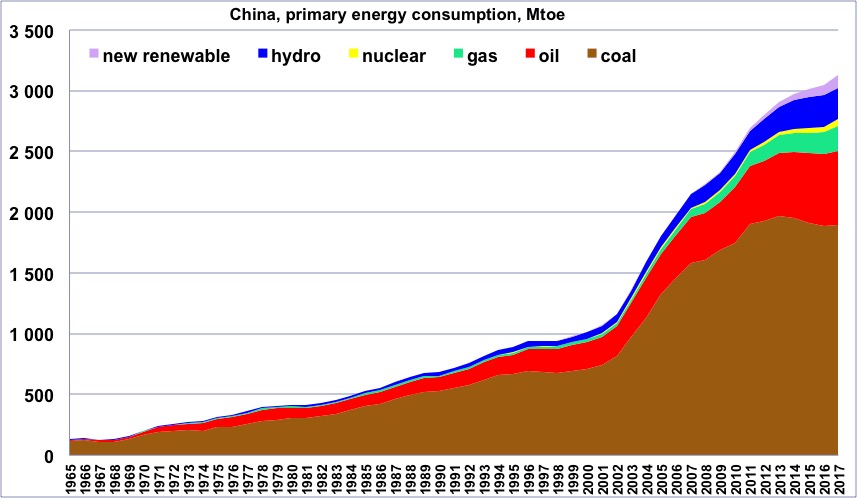
Primary energy consumption of China, wood excluded, from 1965, in million tons oil equivalent.
(one ton oil equivalent = 11600 kWh).
One will notice the spectacular rise of coal and the very low fraction of nuclear and “new renewables” (all renewable energies except wood and hydroelectricity).
Author’s compilation on primary data from BP Statistical Review, 2018
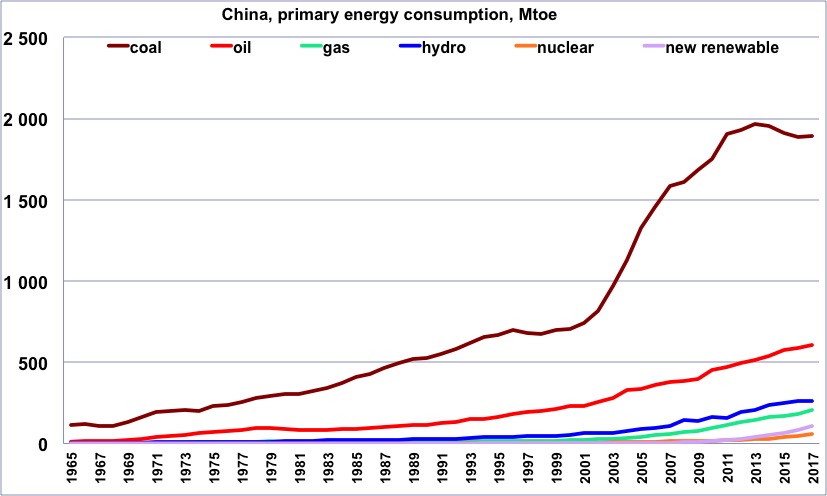
Same as before, but with one curve per energy.
One will notice that coal is more used than oil (when it is the opposite in OECD countries), and that no energy is declining so far.
Author’s compilation on primary data from BP Statistical Review, 2018
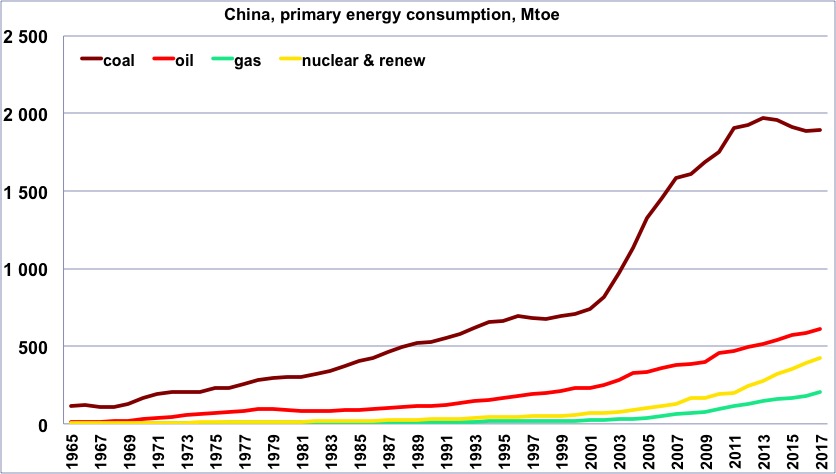
Same as before, but with a curve that totals all “non fossil” production (“non fossil” is anything except coal, gas and oil, and is therefore the sum of nuclear and renewables).
The rise of this contribution is mostly due to the rise of hydroelectricity.
Author’s compilation on primary data from BP Statistical Review, 2018
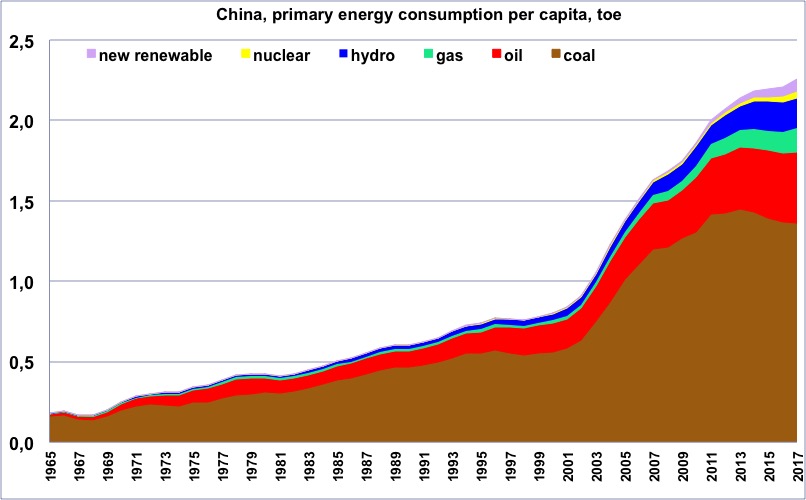
Primary energy consumption per capita in China, wood excluded, from 1965, in tons oil equivalent.
(one ton oil equivalent = 11600 kWh).
“New Renewable” = all renewable energies except wood and hydroelectricity.
Author’s compilation on primary data from BP Statistical Review, 2018, and WorldBank, 2018

Same as before, but with one curve per energy.
Author’s compilation on primary data from BP Statistical Review & World Bank, 2018
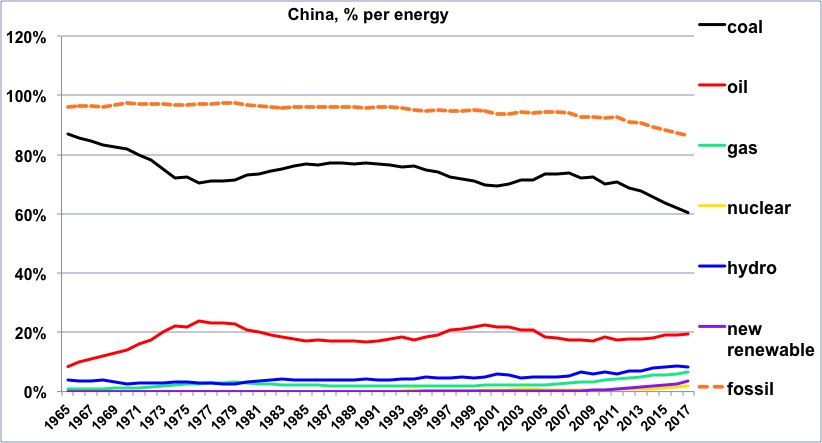
Share of each energy (wood excluded) in China consumption since 1965, and share of the fossil fuels.
One will notice that the share of coal is greater than the share of oil, when it is the opposite in OECD countries. One will also notice that except for hydroelectricity, the non fossil energies are almost inexistant (nuclear included).
Author’s calculation on primary data from BP Statistical Review, 2018

Annual change of the primary energy consumption in China (wood excluded) since 1965.
Author’s calculation on primary data from BP Statistical Review, 2018
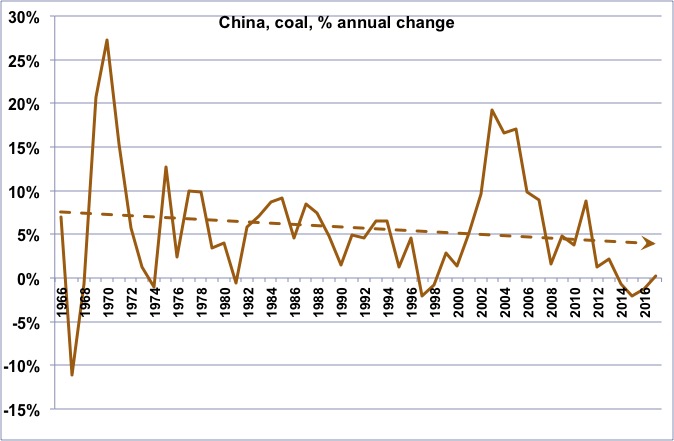
Annual change of the coal consumption in China since 1965.
Author’s calculation on primary data from BP Statistical Review, 2018
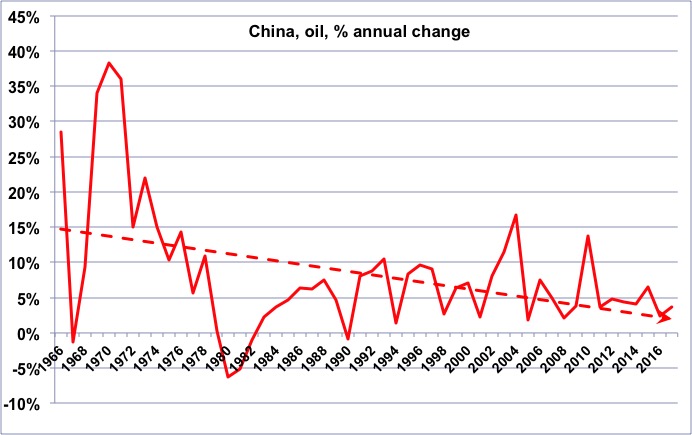
Annual change of the oil consumption in China since 1965.
Author’s calculation on primary data from BP Statistical Review, 2018

Annual change of the gas consumption in China since 1965.
Although the trend over the period is a decline of the growth rate, there is clearly two distinctive episodes, one of a rapid decline (until 1982), then one of a rise again.
Author’s calculation on primary data from BP Statistical Review, 2018

Annual change of the “non fossil” (wood excluded) consumption in China since 1965.
One will notice that, contrary to what can be seen for OECD countries, the trend is to a increase of the growth rate. It is mostly due to the fast rise of hydroelectricity, by far the first “non fossil” energy in China.
Author’s calculation on primary data from BP Statistical Review, 2018

CO2 emissions coming from fossil fuels in China since 1965, in million tonnes.
The total amounts to more than 25% of the world emissions.
Author’s compilation on primary data from BP Statistical Review, 2018
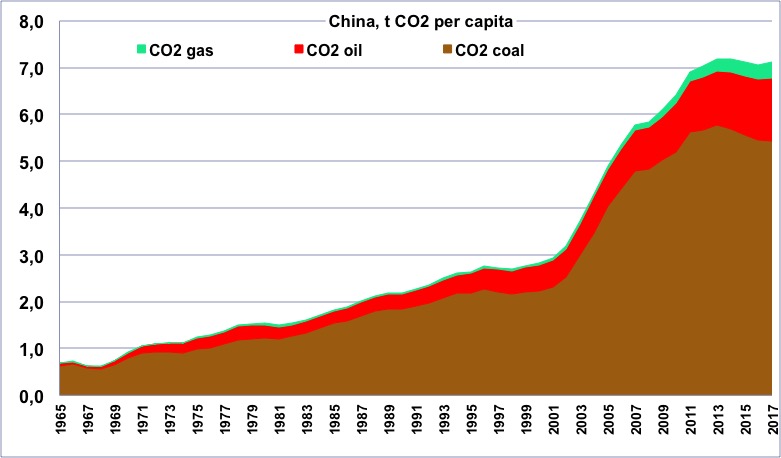
CO2 emissions per capita coming from fossil fuels in China since 1965, in tonnes.
They are now over the world average.
Author’s compilation on primary data from BP Statistical Review & World Bank, 2018
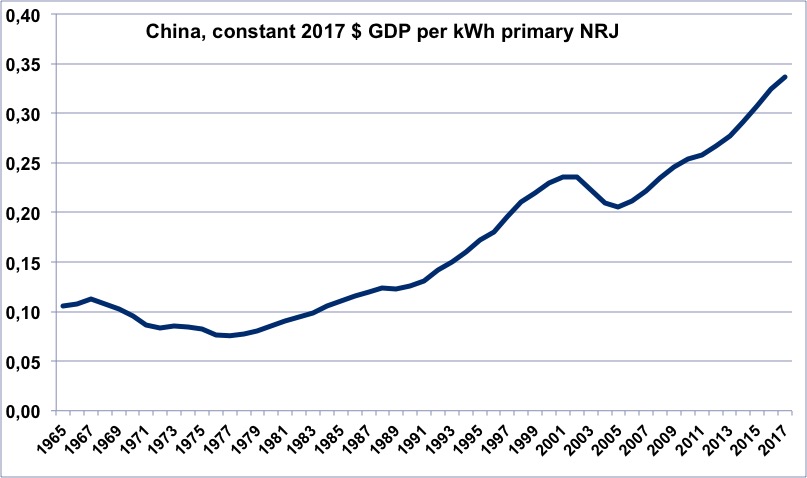
Evolution of the energy efficiency of China since 1965 (constant dollars of GDP per kWh of primary energy).
When the value is increasing, it means that the economy is becoming more efficient. The value in Europe is 0,9 $ of GDP per kWh.
Author’s calculation on primary data from BP Statistical Review, 2018, and World Bank, 2018
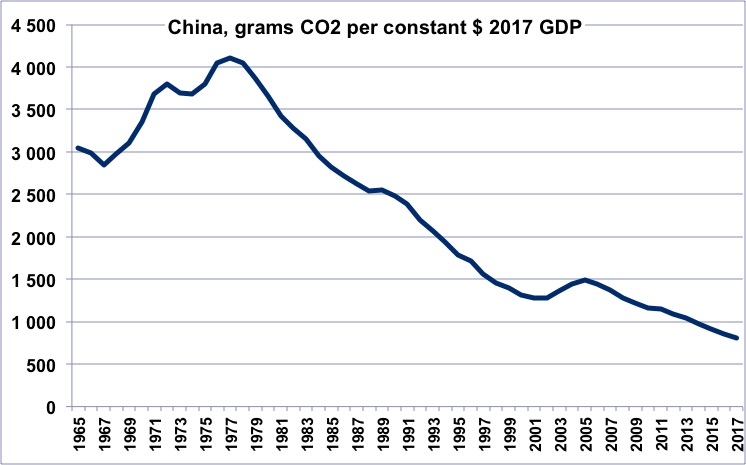
CO2 efficiency of the economy of China since 1965 (grams of CO2 per constant dollar of GDP).
When the value is decreasing, it means that the economy is emitting less per unit of GDP. The present value is 5 times what it is for Europe.
Author’s calculation on primary data from BP Statistical Review, 2018, and World Bank, 2018
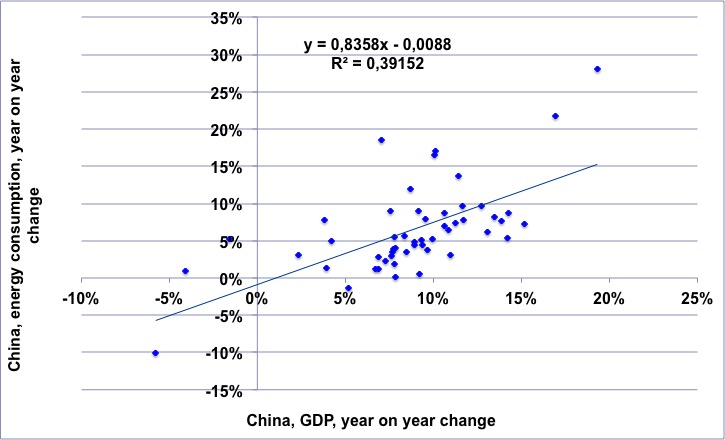
For the 1965-2017 period, annual change of the GDP of China (horizontal axis) vs. annual change of the energy consumption of China.
The regression means that for a 1% growth rate of the GDP there is a slightly less than 1% growth rate of the energy consumption.
NB: over the period, there has not been a single year with a growth of the GDP and a decrease of the energy consumption!
Author’s calculation on primary data from BP Statistical Review, 2018, and World Bank, 2018
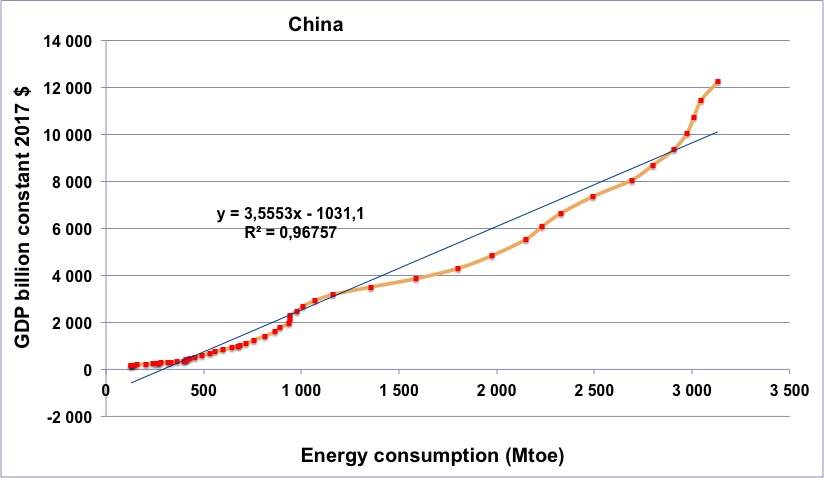
Chinese energy consumption (horizontal axis) vs Chinese GDP (in constant billion dollars) for the period going from 1965 to 2017 (the orange line begins in 1965, at the lower left, and then the dots follow a chronological order going roughly up and right).
Contrary to was can be seen for OECD countries, this curve shows almost no “accidents”, and has remained remarkably linear except for the last years, where at least two competing explanations can be suggested (financial bubbles, that create “artifical” GDP without increasing energy consumption, and “true” energy efficiency of the processes.
Author’s calculation on primary data from BP Statistical Review, 2018, and World Bank, 2018
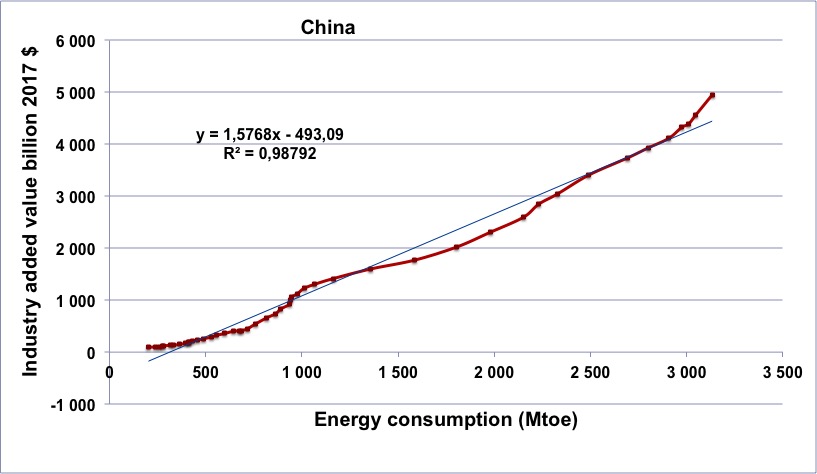
Chinese energy consumption (horizontal axis) vs Chinese industrial output (in constant billion dollars) for the period going from 1970 to 2017 (the brown line begins in 1970, at the lower left, and then the dots follow a chronological order).
The curve is almost a straight line for the whole period, contrary to what can be observed for OECD countries.
Author’s calculation on primary data from BP Statistical Review, 2018, and World Bank, 2018
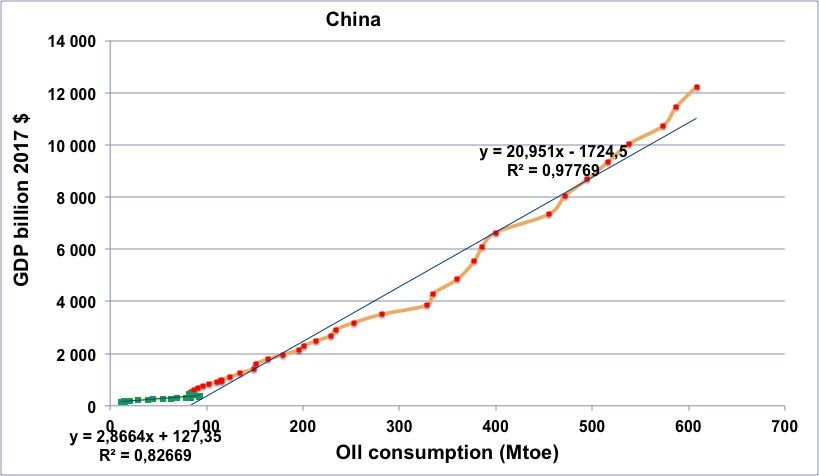
Chinese oil consumption (horizontal axis) vs Chinese GDP (in constant billion dollars) for the period going from 1965 to 2017.
Green dots with yellow line: 1965 to 1982.
Red dots with orange line: 1983 to 2017.
The 1974 and 1979 episodes are invisible, as the 2006 episode. The “oil efficiency” has improved after 1980, but the “oil dependancy” has not disappeared !
Author’s calculation on primary data from BP Statistical Review, 2018, and World Bank, 2018

Electricity generation in China from 1985, in billion kWh.
Coal, coal and coal!
Source: BP Statistical Review 2018
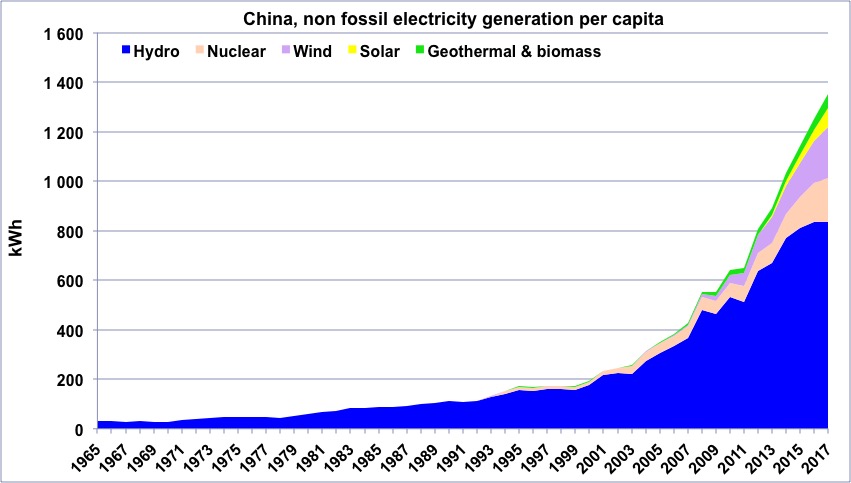
“Non fossil” electricity generation per capita in China since 1965.
This “non fossil” fraction represents about 25% of the total in China.
Author’s compilation on data from BP Statistical Review

Oil production (solid line) and consumption (dotted line) in China since 1965, in million tonnes.
Self-sufficient until the early ’90s, China now imports two thirds of its consumption.
Author’s compilation on data from BP Statistical Review
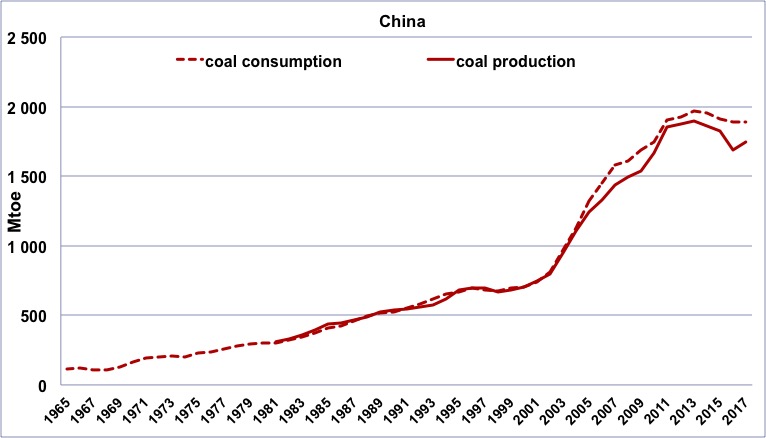
Coal production (solid line, since 1980) and consumption (dotted line, since 1965) in China, in million tonnes oil equivalent (1 tonne oil equivalent of coal ≈ 1,5 to 3 tonnes of coal, depending on its quality).
Coal consumption is mainly reflecting coal production, as it is the case for most significant coal consumers.
Author’s compilation on data from BP Statistical Review

Gas production (solid line, since 1970) and consumption (dotted line, since 1965) in China, in million tonnes oil equivalent (1 tonne oil equivalent of gas ≈ 1000 m3).
Self-sufficient until the late ’00s, China now imports half of its consumption.
Author’s compilation on data from BP Statistical Review